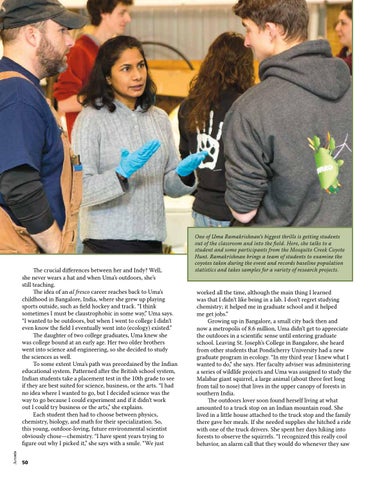Juniata
The crucial differences between her and Indy? Well, she never wears a hat and when Uma’s outdoors, she’s still teaching. The idea of an al fresco career reaches back to Uma’s childhood in Bangalore, India, where she grew up playing sports outside, such as field hockey and track. “I think sometimes I must be claustrophobic in some way,” Uma says. “I wanted to be outdoors, but when I went to college I didn’t even know the field I eventually went into (ecology) existed.” The daughter of two college graduates, Uma knew she was college bound at an early age. Her two older brothers went into science and engineering, so she decided to study the sciences as well. To some extent Uma’s path was preordained by the Indian educational system. Patterned after the British school system, Indian students take a placement test in the 10th grade to see if they are best suited for science, business, or the arts. “I had no idea where I wanted to go, but I decided science was the way to go because I could experiment and if it didn’t work out I could try business or the arts,” she explains. Each student then had to choose between physics, chemistry, biology, and math for their specialization. So, this young, outdoor-loving, future environmental scientist obviously chose—chemistry. “I have spent years trying to figure out why I picked it,” she says with a smile. “We just 50
One of Uma Ramakrishnan’s biggest thrills is getting students out of the classroom and into the field. Here, she talks to a student and some participants from the Mosquito Creek Coyote Hunt. Ramakrishnan brings a team of students to examine the coyotes taken during the event and records baseline population statistics and takes samples for a variety of research projects.
worked all the time, although the main thing I learned was that I didn’t like being in a lab. I don’t regret studying chemistry; it helped me in graduate school and it helped me get jobs.” Growing up in Bangalore, a small city back then and now a metropolis of 8.6 million, Uma didn’t get to appreciate the outdoors in a scientific sense until entering graduate school. Leaving St. Joseph’s College in Bangalore, she heard from other students that Pondicherry University had a new graduate program in ecology. “In my third year I knew what I wanted to do,” she says. Her faculty adviser was administering a series of wildlife projects and Uma was assigned to study the Malabar giant squirrel, a large animal (about three feet long from tail to nose) that lives in the upper canopy of forests in southern India. The outdoors lover soon found herself living at what amounted to a truck stop on an Indian mountain road. She lived in a little house attached to the truck stop and the family there gave her meals. If she needed supplies she hitched a ride with one of the truck drivers. She spent her days hiking into forests to observe the squirrels. “I recognized this really cool behavior, an alarm call that they would do whenever they saw
